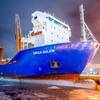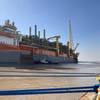Shipowners are now better placed to cope with soaring fuel prices because of growth in trade as Asia recovers from economic crisis, industry sources and analysts said.
The price of bunker fuel, which typically makes up about five percent of a shipper's total operating costs, has - over the past six months - doubled to $140 per ton.
The spoils from improved conditions have not been evenly shared within the industry, with tanker owners hit the worst.
Three global-pacts among oil producers to cut output and shore up prices have had a negative impact on tanker owners who now face higher bunker costs and lower shipping volumes.
The producers agreed to remove from world oil production about 5.1 million bpd of crude oil, which sent benchmark Brent crude soaring to around $24 per barrel last Wednesday from less than $13 in March.
Freight Rates To Rescue Bruised Bottom Line
"Definitely there is a squeeze on margins...it will erode margins by one to two percent, which I think can be quite significant to bottom line given that shipping companies' margins are quite fine," said shipping analyst Wong Kum Seng at brokerage firm G.K. Goh.
Wong said the extent of the damage would vary from shipper to shipper depending on their exposure.
He said the downside would be minimized if the bulk of a shipowners' fixtures were on a trip basis or if the bunker component in a time charter was not fixed.
Industry sources said some shipowners, who had at the start of the year aggressively bid for charter contracts, were now paying for them heavily.
"I know of some shipowners who are crying now after fixing some charter contracts at very low rates. The bunker price alone was $70-$80," one independent bunker supplier said.
Shipowners say the regional economic recovery was definitely filtering through into the shipping sector.
"Volume has been improving. If you look at the port throughput alone, it's gone up by seven to eight percent," said Dhrubajyoti Das, executive director, investor relations, of regional shipper Samudera Shipping Line.
Das said increase in volume was also seen in the number of empty containers carried with the laden/unladen mix now at 80/20 compared with 75/25 earlier this year.
He said freight rates for the regional routes had not risen significantly since fuel prices shot up in March but there were clear signs of a recovery.
"The long haul freight rates have gone up by 20 percent. The important thing is the regionals have stopped falling. It has stabilized and we see certain signal of a recovery," Das said.
G.K. Goh's Wong said: "(fuel cost) is only going to be a major issue if freight rates were going on a down trend but it looks like rates are on a recovery."
To Hedge Or Not To Hedge
The bigger liners, which are already benefiting from the rise in long haul freight rates, were also seen leveraging on their financial prowess to hedge part of their fuel costs.
Oil derivative traders said when bunker prices were sagging in the $60 range in February, some Asian liners such as Neptune Orient Lines and China Ocean Shipping (COSCO) were among shippers who had locked in fuel costs at the low level.
"Many shipping companies are adverse to using the swaps market and even those who do only hedge about half of their exposure," one oil trader said.
They said Japanese liners were among the most conservative and did not take part in the derivative trade.
"If these guys had bought when fuel oil was at $50-60, they would be laughing all the way to the bank," one trader said.
The Singapore over-the-counter fuel oil derivatives market is actively used by oil industry players to hedge exposures and is increasingly used by others such as power companies and shippers to hedge fuel costs.
Subscribe for
Maritime Reporter E-News
Maritime Reporter E-News is the maritime industry's largest circulation and most authoritative ENews Service, delivered to your Email five times per week












